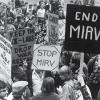
Topics:
This week, Deborah Douglas, is our guest contributor.
On Tuesday, November 5th, Radius and the MIT Museum will be presenting a full screening of an historic documentary: November Actions, Richard Leacock’s unfinished film--now in an edited form. This is possibly the best film ever made about MIT: a rare and raw look at the MIT community grappling with a crisis—economic, political and moral—without judgment. Leacock’s approach is a swirl of activities, acronyms, Robert’s Rules of Order, shouted accusations, songs, introspection, frustration, optimism, and more. It is not a complete history of Vietnam era activism at MIT. It is one person's account of a moment in time.
When Leacock was hired by MIT 50 years ago today, he had emerged as one of the world’s leading experimental documentary filmmakers and MIT was just starting to offer courses in this area. In his autobiography, A Feeling of Being There, Leacock wrote: “I packed a bag and took a bus to Boston. However, when I got there in 1969, the place was in turmoil over the war in Vietnam…chaos was everywhere.”
Chaos indeed! Following a major outburst of anti-war activism in the spring of 1969, most especially the famous March 4 protest, there had been a growing movement on MIT’s campus that was expressing not only general opposition to the war in Southeast Asia but more specifically to MIT’s contributions to the military-industrial-complex. MIT’s Instrumentation Lab might have been the darling of world on July 20, 1969 when astronauts Neil Armstrong and Buzz Aldrin landed on the moon but now people were very aware that the same guidance systems that had made that mission such a success were at the heart of the new ICBM technologies. A growing number of people at MIT and beyond were becoming increasingly critical of the conduct of classified military research on campus.
In the summer, a plan for a protest at the MIT I-Labs in November 1969 was launched. Reading articles in The Tech (and elsewhere) beginning in September really reveals the rapidly escalating tensions at the Institute. Everyone had been shocked by the violence at Harvard when students occupied University Hall in April 1969. The sight of students being arrested, struck with Billy clubs, maced and being dragged out was not something Institute officials wanted to see repeated at MIT. Could MIT respond differently? Did there have to be violence? What should MIT do about the issue of classified research? In filming the events of the protest, Leacock discovered that the real action at MIT was behind-the-scenes as a group of administrators, faculty and students met together to address what is recognized now as one of MIT’s starkest inflection points.
And yet, if current events leave you wondering about MIT, this film is a powerful object lesson and may be even more relevant today than when it was first made 50 years ago.

